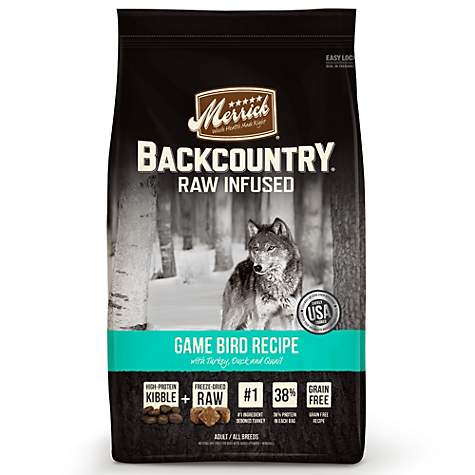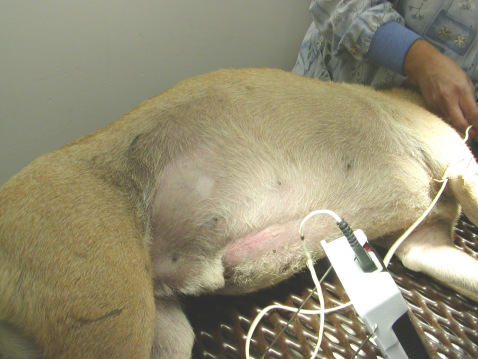What is Bloat?
Bloat is a very serious health risk for many dogs, yet most dog owners know little about it. It is the second leading killer of dogs, after cancer. It is frequently reported that deep-chested dogs, such as Malamutes, and particularly some lines are at risk. We are aware of several Malamute breeders that routinely "tack" their dog's stomachs to prevent torsion should the dog's bloat. Personally, we fell if you must do that regularly and for most dogs, perhaps you need to change your breeding program.
If you believe your dog is experiencing bloat, please get your dog to a veterinarian immediately! Do NOT take time to read this! If you're wrong, no harm done - if you're right, you are wasting precious time. The time to read this is BEFORE you may need it. Bloat can kill in less than 20 minutes - so time is of the essence. Call your vet to alert them you're on your way with a suspected bloat case. If they don't take you seriously, call a different vet and get there fast. 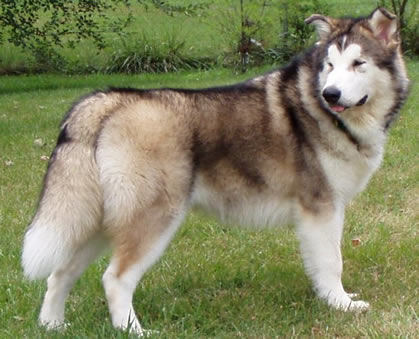
The technical name for bloat is "Gastric Dilatation-Volvulus" ("GDV"). Bloating of the stomach is often related to swallowed air (although food and fluid can also be present). It usually happens when there's an abnormal accumulation of air, fluid, and/or foam in the stomach causing the stomach to look abnormally large and hard. Stress can be a significant contributing factor also. Bloat can occur with or without the stomach twisting. Either way it is life threatening. When the stomach swells, it may rotate 90° to 360°, twisting between its fixed attachments at the esophagus (food tube) and at the duodenum (the upper intestine).
The twisting stomach traps air, food, and water in the stomach and cuts off blood circulation to vital organs causing those organs to die. The bloated stomach obstructs veins in the abdomen, leading to low blood pressure, shock, and damage to internal organs. All this will kill the dog in a very short period of time (like 20 minutes to an hour!) It's a very painful way to die. Imagine having the worst stomach cramps of your life, and dying from them - that's what bloat feels like.. Every large breed dog owner should have a plan and the phone number of a NEARBY 24/7 veterinarian that can handle bloat. Some veterinarians apparently do not like to deal with bloat or are inexperienced with how to handle it. It is important you find this information out in advance. However, if they are willing to try, and you have no other options, that's the best you can do - but it pays to have a plan ahead of time with an experienced vet as the outcome is usually better.
- If your regular vet doesn't have 24-hour emergency service, know which nearby vet you would use. Keep the phone number handy.
- If you are traveling, note vet offices as you drive and find out who the local vets are where you stay. That saved Gracie's' life. For some unknown reason I happened to be counting and noting where all the vet offices were that day - call it ESP or a Premonition, but it probably saved her life because we remembered seeing Dr. Tim's office as we came into town.
- Always keep a product with simethicone on hand (e.g., Mylanta Gas (not regular Mylanta), Gas-X, etc.) in case your dog has gas. If you can reduce or slow the gas, you've probably bought yourself a little more time to get to a vet if your dog is bloating.
- If you have a breed that is high on the bloat list, and you feel comfortable doing a medical procedure - it may be prudent to have a bloat needle on hand for emergencies (called Tubing). Not many vets will give you a bloat needle because in inexperienced hands, it can cause serious complications. However, if you can ge your vet to give you one, and you live far from veterinary care, it may buy you time. It's not something to do lightly, however, as you risk puncturing the spleen or other internal organs if you do not know what you are doing. It's very risky, but if you are in a location where a vet is more than an hour away, it might just save your dog's life. The dog will still need follow up care (to untwist and pump the stomach), but as a desperation measure, this may buy you time
Our Perspective and Story
Typical symptoms often include some some of the following. From the onset of the first symptoms you have very little time (sometimes minutes) to get immediate medical attention for your dog. We can't stress this enough - YOU HAVE MINUTES TO GET TO THE VET where the vet will put a tube down the dog's throat and attempt to remove the gas and food. If the stomach has already torsioned, or to relieve pressure they may stick a trocar needle in the stomach to allow the gas to escape. Bloat is very painful, but in it's early stages the symptoms are very subtle - Gracie's were - she merely looked uncomfortable, seemed to be in pain, and was drooling - just a little. Other times we've only realized they were bloating because we'd seen it before. If the abdomen feels tight and full, the dog may or may not be dry heaving or restless. The symptoms, particularly in Malamutes because they do have such a high pain threshold are subtle. Know your dog and know when it's not acting right. Be aware that waiting to determine if you are correct is wasting time.
Years ago, when the girls were small, Homer seemed to be bloating. His sides felt very full, he was crying in pain, and just wanted to lie down. I quickly put Homer in the van and ran back to get my two toddlers. We didn't waste time even putting shoes on as there is no time to waste with bloat. I put the kids in their car seats and jumped in. As I put the van in gear, Homer let out the biggest smelliest fart I've ever smelled. He was ok...it was a false alarm. Like a fire drill, it was an excellent lesson in priorities and moving quickly. Looking back, the one mistake I made was not calling the vet first to let them know I was on my way (this was before cell phones). I could have lost precious time getting to the vet office and finding no one that could help there. Lesson learned! Homer never had an episode after that.
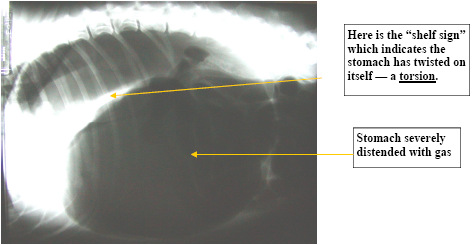
We've had four dogs bloat over the years.. In each case the stomach was big, hard and tight. The dogs were restless and obviously uncomfortable. Some cried, some did not.. With Riggs it started quite beginely, he had a lot of gas the day before and we were able to give him Di-Gel which seemed to help initially, though he ultimately bloated while I was on my way to the vet with him. He'd been uncomfortable overnight and had excessive gas overnight (but was still farting and burping and his stomach wasn't hard yet), so I was already heading to the vet as a precaution the next morning when it happened. On the way there he began crying and getting VERY restless. We arrived only 20 minutes after his first real symptoms and he had already torsioned 360 degrees which meant immediate surgery. I later learned he had a very small chance of survival with that much torsion, only because we were already on our way did we have enough time.
With Gracie it was more insidious...Dan noticed her stomach was big and hard. No other symptoms until about 10 minutes later when she tried to throw up and couldn't. We were out of town at the time in Marquette, MI. Hers is a story as to why you need to be prepared no matter WHERE you are...had Dan not noticed it early, and had we not found a wonderful vet at 8:00 pm by accident, Gracie would be dead. Only when she was in serious trouble (by then we were at Dr. Tim's) did she begin to act in serious distress and lie down. If she were out in a kennel I'm sure it would have been missed completely!!! She didn't cry, she didn't pant, she didn't do ANYTHING out of the ordinary, and even pooped before it started. The only symptom was her large hard stomach. What Dr. Tim did when we arrived was amazing and the calling card of an excellent vet. He didn't wait for "staff" to arrive, he had Dan help him do everything because time was of the essence. First they x-rayed her to see where she was at. It hadn't torsioned yet. There is no point in putting a tube down her throat to get out the gas if it's already twisted. Then he started an IV drip with pain meds. They then stuck her with a bloat needle to remove the gas - it sounded like the air being let out of a basketball!!! Next he intubed her and got the remaining food out of her stomach, then filled it with Mylanta and watched her overnight. Because it was still attempting to torsion, he did surgery the next morning tacking the stomach so it could not twist. Gracie bloated 3 more times over a couple of years, the last being her final one that killed her..
Typical Symptoms
A HARD, huge stomach. Bloated abdomen that may feel tight (like a drum) Despite the term "bloat," many times this symptom never occurs or is not very apparent.
Attempting to unsuccessfully vomit. "Unsuccessful vomiting" means either nothing comes up or possibly just foam and/or mucous comes up.
Not acting like usual self. If this is combined with frequent attempts to vomit, and if your dog doesn't typically ask to go outside in the middle of the night, bloat is a very real possibility. Just keep in mind ANY of these symptoms may or may not be present.
- Anxiety, Nervousness, Restlessness - one of the earliest warning signs
- Hunching up, or roaching back, not wanting to move
- Lack of normal gurgling and digestive sounds in the tummy
- Pale or off-color gums - Dark red in early stages, white or blue in later stages
- Coughing
- Unproductive gagging
- Heavy salivating or drooling
- Foamy mucous around the lips, or vomiting foamy mucous
- Licking the air
- Seeking a hiding place
- Looking at their side or other evidence of discomfort in the abdomen
- May refuse to lie down or sit
- Unproductive attempts to defecate
- Whining
- Pacing
- Drinking excessively
- Heavy or rapid panting
- Shallow breathing
- Cold mouth membranes
- Apparently weakness, unable to stand - especially in advanced stage
- Weak pulse
- Collapse
- May lie down and refuse to get up
- May stand spread-legged
- May curl up or go into a crouched position
- May attempt to eat grass, stones or twigs
Causes of Bloat
It is believed the following may be the primary contributors to bloat. I'm not sure I agree with all of them - or at least they didn't seem to be important to us. Purdue University's School of Veterinary Medicine has chart to determine your dog's chances of bloating, click here.
- Stress - Dog shows, mating, whelping, boarding, change in routine, pack order issues, new dog in household, etc.
- Activities that result in gulping air
- Elevated food bowls
- Rapid eating
- Eating dry foods that contain citric acid as a preservative (risk is worse if food is moistened)
- Extruded dry food that swells when wet
- Eating dry foods that contain fat among the first four ingredients
- Insufficient Trypsin (a pancreatic enzyme present in meat)
- Dilution of gastric juices necessary for complete digestion by drinking too much water before or after eating
- Eating gas-producing foods (especially soybean products, brewer's yeast, and alfalfa)
- Exercise before and especially after eating
- Heredity (especially having a first-degree relative who has bloated)
- Having a deep or wide chest
- Older dogs, big dogs, male dogs
- Fearful and anxious temperament
- Prone to stress
- Dog and people aggression history
Preventing Bloat
Origianlly I felt that there is nothing you can really do to avoid bloat. However after dealing with an elderly Mulan bloating twice in a week we realized that stress was an important factor. A stressed dog is more likely to bloat. Eliminate the stress and you can eliminate one of the big factors in bloating. In Mulan's case, she had what's known as "Sundowners"...a type of anxiety brought on by low light in the evening and canine dementia - which we didn't even suspect until she had bloated twice. Once we realized the cause, the vet put her on Trazodone and no incidents since.. On the other hand, Riggs was home hanging out watching TV like he always did. Gracie was at a dog show with several of our other dogs. Kara was just hanging out in her crate for the night. The only common denomiater is that they were either large dogs (Gracie & Riggs), or smaller but large chested dogs (Mulan & Kara). One theory is that it's caused by an inherited bacteria in some dog stomachs. That makes more sense than a lot of other "causes" but I now feel stress is a bigger factor than once thought. Bloat does seem to run in certain lines - and certain kennels - which like a hereditary factor must be involved. Yet of all of our related dogs - in 20+ years only 3 of some 50+ dogs bloated (including pups in other homes). They say broad chests are more prone to bloat because the excess space gives the stomach somewhere to go when it expands. A dog rolling over would not twist for no apparent reason - without some other factor involved.
- Avoid highly stressful situations. If you can't avoid them, try to minimize the stress as much as possible. Be extra watchful. Can be brought on by dog shows, mating, whelping, boarding, new dog in household, change in routine, or even light levels, etc.
- Do not use an elevated food bowl (at one time they recommend this, however this has changed)
- Don't let your dog gulp air or food. Some dogs will gulp air when nervous.
- Smaller, more frequent meals instead of 1 or 2 large meals.
- Do not exercise for at least an hour (longer if possible) before and especially after eating. Particularly avoid vigorous exercise and don't permit your dog to roll over, which could cause the stomach to twist.
- Don't permit rapid eating or food gulping.
- Use extruded kibble foods rather than foods that tend to "swell" - better yet, feed a natural raw diet.
- Do not give water one hour before or after a meal
It dilutes the gastric juices necessary for proper digestion, which leads to gas production. - Always keep a product with simethicone (e.g., Mylanta Gas (not regular Mylanta), Di-Gel, Phazyme, Gas-X, etc.) on hand to treat gas symptoms. Some recommend giving your dog simethicone immediately if your dog burps more than once or shows other signs of gas. Some report relief of gas symptoms with 1/2 tsp of nutmeg or the homeopathic remedy Nux moschata 30
- Allow access to fresh water at all times, except before and after meals
- When switching dog food, do so gradually (allow several weeks)
- Feed a high-protein (greater than 30%) diet, particularly of raw meat
- Do not feed dry food exclusively
- If feeding dry food, avoid foods that contain fat as one of the first four ingredients
- If feeding dry foods, avoid foods that contain citric acid If you must use a dry food containing citric acid, do not pre-moisten the food
- Feed a high-quality diet
- Use a dry food that includes rendered meat meal with bone among the first four ingredients
- Feed adequate amount of fiber (for commercial dog food, at least 3.00% crude fiber)
- Reduce carbohydrates as much as possible (e.g., typical in many commercial dog biscuits)
- Make meals a peaceful, stress-free time
- Avoid brewer's yeast, alfalfa, and soybean products
- Included herbs specially mixed for Malamutes that reduce gas
- Add enzyme products to food such as Prozyme
- Promote "friendly" bacteria in the intestine, e.g. from yogurt or supplemental acidophilus
- Avoids fermentation of carbohydrates, which can cause gas quickly. This is especially a concern when antibiotics are given since they tend to reduce levels of "friendly" bacteria.
- Don't permit excessive, rapid drinking - Especially on hot days
- If you have an elderly dog (over 6 yrs generally) and the dog becomes nervous and restless after about 4pm but is fine during the day you may be dealing with Sundowners syndrome - which can cause enough stress to make the dog bloat.
Breeds at Greatest Risk
- Afgan Hound
- Airdale Terrier
- Akita
- ALASKAN MALAMUTE
- Basset Hound
- Bernese Mountain Dog
- Borzoi
- Bouvier des Flandres
- Boxer
- Bullmastiff
- Chesapeake Bay Retriever
- Collie
- Dachshund
- Doberman Pinscher
- English Springer Spaniel
- Fila Brasileiro
- Golden Retriever
- Gordon Setter
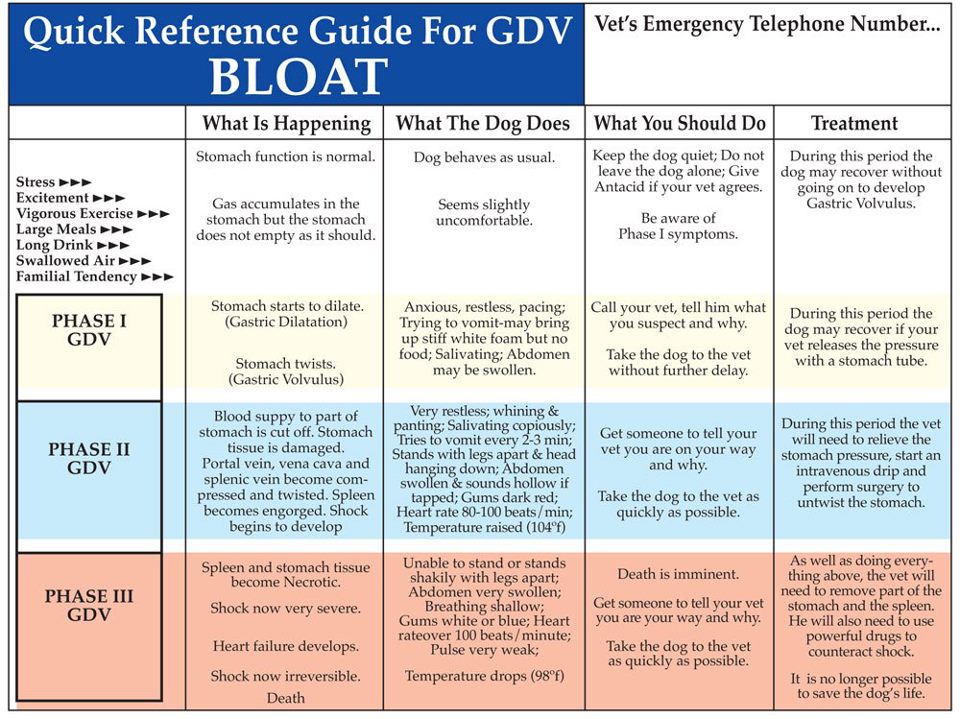 <
<
This information is not intended to replace advice or guidance from veterinarians or other Malamute care professionals. If you are concerned your dog is bloating, you shouldn't be reading this - you should be speeding to a veterinarian!
More information & Helpful links...
Bloat Research Information from Purdue University













